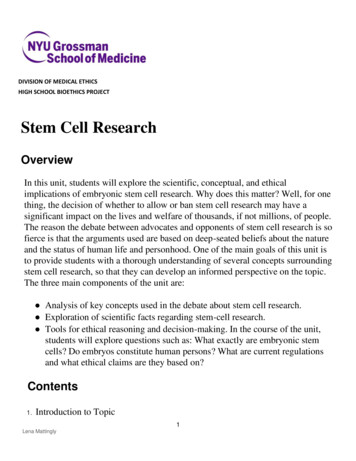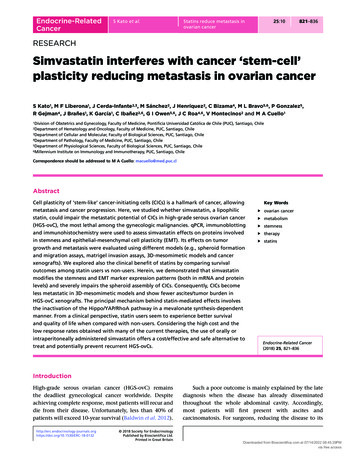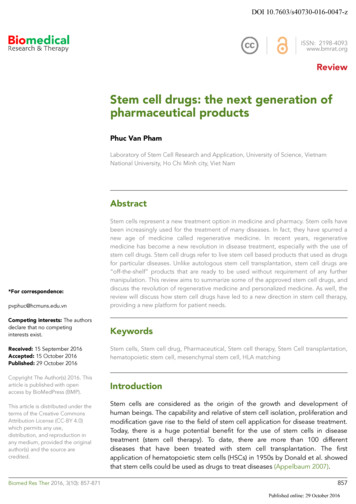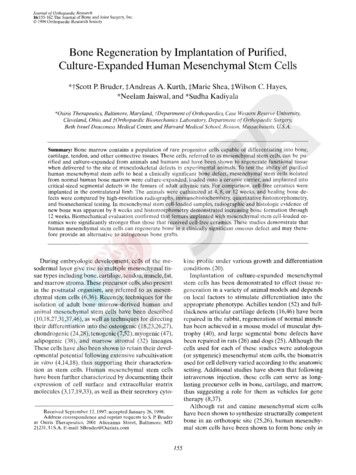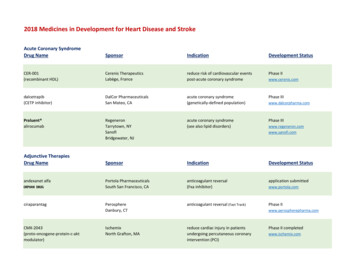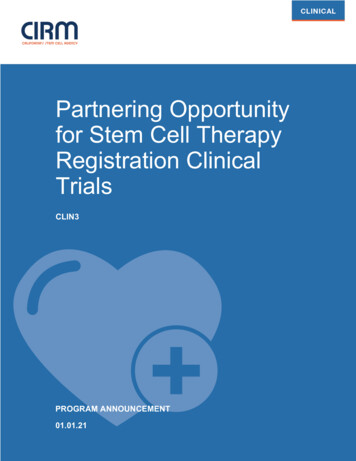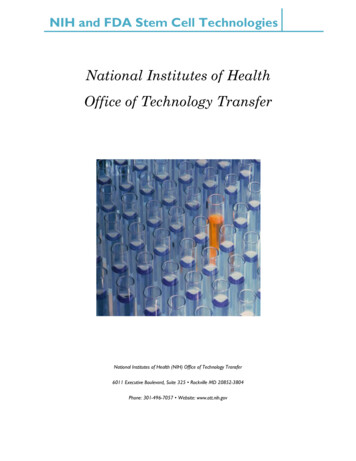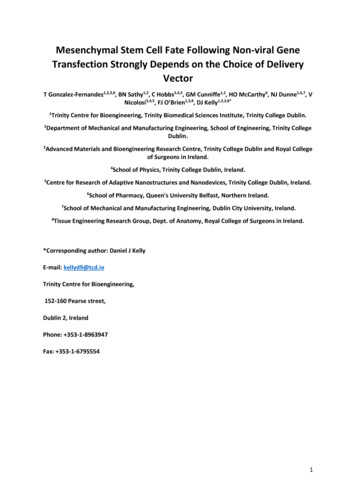
Transcription
Mesenchymal Stem Cell Fate Following Non-viral GeneTransfection Strongly Depends on the Choice of DeliveryVectorT Gonzalez-Fernandez1,2,3,8, BN Sathy1,2, C Hobbs3,4,5, GM Cunniffe1,2, HO McCarthy6, NJ Dunne1,6,7, VNicolosi3,4,5, FJ O’Brien1,3,8, DJ Kelly1,2,3,8*1Trinity Centre for Bioengineering, Trinity Biomedical Sciences Institute, Trinity College Dublin.2Department of Mechanical and Manufacturing Engineering, School of Engineering, Trinity CollegeDublin.3Advanced Materials and Bioengineering Research Centre, Trinity College Dublin and Royal Collegeof Surgeons in Ireland.4School of Physics, Trinity College Dublin, Ireland.5Centre for Research of Adaptive Nanostructures and Nanodevices, Trinity College Dublin, Ireland.6School of Pharmacy, Queen's University Belfast, Northern Ireland.7School of Mechanical and Manufacturing Engineering, Dublin City University, Ireland.8Tissue Engineering Research Group, Dept. of Anatomy, Royal College of Surgeons in Ireland.*Corresponding author: Daniel J KellyE-mail: kellyd9@tcd.ieTrinity Centre for Bioengineering,152-160 Pearse street,Dublin 2, IrelandPhone: 353-1-8963947Fax: 353-1-67955541
ABSTRACTControlling the phenotype of mesenchymal stem cells (MSCs) through the delivery of regulatorygenes is a promising strategy in tissue engineering (TE). Essential to effective gene delivery is thechoice of gene carrier. Non-viral delivery vectors have been extensively used in TE, however theirintrinsic effects on MSC differentiation remain poorly understood. The objective of this study was toinvestigate the influence of three different classes of non-viral gene delivery vectors: (1) cationicpolymers (polyethylenimine, PEI), (2) inorganic nanoparticles (nanohydroxyapatite, nHA) and (3)amphipathic peptides (RALA peptide) on modulating stem cell fate after reporter and therapeutic genedelivery. Despite facilitating similar reporter gene transfection efficiencies, these nanoparticle-basedvectors had dramatically different effects on MSC viability, cytoskeletal morphology anddifferentiation. After reporter gene delivery (pGFP or pLUC), the nHA and RALA vectors supported anelongated MSC morphology, actin stress fibre formation and the development of mature focaladhesions, while cells appeared rounded and less tense following PEI transfection. These changes inMSC morphology correlated with enhanced osteogenesis following nHA and RALA transfection andadipogenesis following PEI transfection. When therapeutic genes encoding for transforming growthfactor beta 3 (TGF-β3) and/or bone morphogenic protein 2 (BMP2) were delivered to MSCs, nHApromoted osteogenesis in 2D culture and the development of an endochondral phenotype in 3Dculture, while RALA was less osteogenic and appeared to promote a more stable hyaline cartilage-likephenotype. In contrast, PEI failed to induce robust osteogenesis or chondrogenesis of MSCs, despiteeffective therapeutic protein production. Taken together, these results demonstrate that thedifferentiation of MSCs through the application of non-viral gene delivery strategies depends not onlyon the gene delivered, but also on the gene carrier itself.KEY WORDS: non-viral gene delivery; nanoparticle-based gene delivery vectors; MSC differentiation;MSC transfection1. INTRODUCTIONAdult mesenchymal stem cells (MSCs) are a promising cell source for regenerative medicine dueto their multipotent differentiation capacity [1] and immunomodulatory properties [2]. Controllingthe phenotype of MSCs is a central challenge in tissue engineering and regenerative medicine. Thefate of progenitor cells can potentially be modulated through the introduction of exogenous genes forthe cell-mediated synthesis of specific proteins. This approach may be preferable over the delivery ofrecombinant cytokines and growth factors which involves the administration of non-physiologicalconcentrations, due to the short half-life and fast body clearance and a lower therapeutic effect incomparison to natural proteins [3–5]. A variety of genes have been explored to this end, including2
members of the transforming growth factor-beta (TGF-β) superfamily of proteins such as bonemorphogenic protein 2 (BMP2) and transforming growth factor-beta 3 (TGF-β3), whoseoverexpression has been previously reported to enhance bone and cartilage regeneration in vivo[6–8]. But the success of gene therapy ultimately depends on the gene delivery mechanism tomaximise nucleic acid uptake and, consequently, downstream protein production [3,4,9–11].Traditionally, viral vectors such as retrovirus, lentivirus and adenovirus, have been used forthe delivery of genes into cells via a process known as transduction [10,12,13]. Although they offerhigh transduction efficiencies and stable gene expression, many limitations remain associated withviral vectors [14–16] such as insertional mutagenesis [17], immunogenicity [11], limited DNApackaging capacity [18] and cumbersome large-scale production [19]. Non-viral gene carriers arepromising alternatives for gene delivery and have the potential to address these limitations [9].Moreover, the transient expression associated with these systems can be more compatible with thenatural wound healing processes [20]. Several non-viral vectors are commonly used for gene delivery,including lipids, polymers, cell penetrating peptides (CPPs) and inorganic nanoparticles [13]. Whilesuch systems can be used to efficiently transfect cells with specific genes, the effects that these nonviral vectors have on stem cell fate remains relatively unknown [21,22].Cationic lipid-based and polymeric DNA vectors such as lipofectamine and polyethylenimine(PEI) are amongst the most widely used non-viral gene delivery methods [13,22,23], and are oftenused as a gold standard for non-viral gene transfection [3]. However their potential cytotoxicity [13,24]and sensitivity to media supplementation with serum and antibiotics [25] limits their use in tissueengineering applications. Among alternative options, inorganic nanoparticles made of calciumphosphate, gold or silica, have been drawing attention for their use in tissue engineering due to theirbiocompatibility, wider availability, long-term stability, ease of preparation and low toxicity [3,26–28].More recently, different classes of peptides [29,30], such as the RALA amphipathic peptide (RALA)comprised of repeating arginine/alanine/leucine/alanine units [30], have been developed as novelnucleic acid carriers [31,32], showing excellent cytocompatibility and moderate transfectionefficiencies in vivo and in vitro [30,33]. These non-viral delivery vehicles are promising in terms ofcompatibility and transfection efficiency, however the suitability of a gene delivery vector for stemcell-mediated tissue engineering is not only determined by its transfection efficiency,cytocompatibility and levels of expression of the gene product, but also by its chemical compositionand how the intracellular delivery of such nanomaterials may influence stem cell fate [22].Therefore, the objective of this study was to first compare the capacity of three differentclasses of non-viral gene delivery vectors (PEI, nanohydroxyapatite (nHA) and RALA) to transfect bone3
marrow-derived MSCs. The impact of intracellular delivery of such nanomaterials on the viability,cytoskeletal structure and multi-lineage differentiation potential of MSCs was assessed. We then usedthese vectors to deliver BMP2 and TGF-β3 genes to MSCs as a means to promote either osteogenesisor chondrogenesis in a 2D or 3D environment, and investigated the influence of different gene carrierson MSC lineage commitment. Collectively the results of this study demonstrate that gene vectors withcomparable capacities to transfect MSCs with reporter and therapeutic genes can have dramaticallydifferent effects on MSC differentiation.2. MATERIALS AND METHODS2.1. Plasmid propagationFour different plasmids were used in the current study: two plasmids encoding for the reporter genesgreen fluorescent protein (pGFP, Amaxa, Lonza Cologne AG, Germany) and luciferase (pLUC, pGaussiaLuciferase; New England Biolabs, Massachusetts, USA), and another two encoding for the therapeuticgenes BMP2 (donation from Prof. Kazihusa Bessho, Kyoto University, Japan) and TGF-β3 (InvivoGen,Ireland). Plasmid amplification was performed by transforming chemically competent Escherichia colibacterial cells (One Shot TOP10; Biosciences, Ireland) according to the manufacturer’s protocol. Thetransformed bacteria were cultured on LB plates with 50 mg/L kanamycin (Sigma-Aldrich, Ireland) asthe selective antibiotic for pGFP and 100 mg/L ampicillin (Sigma-Aldrich, ireland) as the selectiveantibiotic for pLUC, pTGF-β3, and pBMP2. Bacterial colonies were harvested and inoculated in LB broth(Sigma-Aldrich, Ireland) and incubated overnight for further amplification. The harvested bacterialcells were then lysed, and the respective pDNA samples were purified using qiagen plasmid kit(MaxiPrep Kit; Qiagen, Ireland). Nucleic acid concentration (ng/µL) was determined by analyzing the260:280 ratio and 230 nm measurement using NanoDrop spectrophotometer (Labtech International,Uckfield, UK). Plasmids in this study were used at a concentration of 0.5 µg plasmid in 1 µL Tris–EDTA(TE) buffer.2.2. Preparation of delivery vectors and vector-pDNA complexesThe synthesis of the nHA particles was performed as previously described [34]. Briefly, a solution of12 mM sodium phosphate (Sigma-Aldrich, Ireland), containing 0.017% DARVAN821A (RTVanderbilt,Norwalk, USA) was added to an equal volume of a 20 mM calcium chloride solution (Sigma-Aldrich,Ireland) and filtered through a 0.2 mm filter (Fisher, Ireland). nHA-pDNA complexes were prepared byadding 150 µL of the nHA solution to 2 µg of pDNA pretreated with 0.25 M CaCl2 (Sigma-Aldrich,Ireland) as previously optimized [26,27]. The nHA-pDNA solutions were not incubated prior totransfection in order to avoid particle aggregation that could impair cellular uptake as previouslyoptimized [26].4
PEI-pDNA complexes were prepared using branched PEI with a molecular weight of 25kDA (SigmaAldrich, Ireland). PEI was condensed with pDNA in an N:P ratio (the molar ratio of positively chargednitrogen atoms in the PEI to negatively charged phosphates in the pDNA backbone) of 7, a ratiopreviously optimized for MSC transfection [35]. The PEI-pDNA solution was then incubated for 30minutes for complex formation.The RALA peptide was synthesised as previously described [30]. Briefly, the peptide was produced by9-fluorenylmethyloxycarbonyl (Fmoc) solid-state peptide synthesis (Biomatik, USA) and supplied as adesalted, lyophilised powder. The product was purified and validated by reversed-phase highperformance liquid chromatography (RPHPLC); molecular mass was confirmed as 3327.98. The RALApDNA complexes were prepared at N:P ratio of 6, previously optimized to achieve low cytotoxicity andhigh transfection efficiency [30,33]. The RALA-pDNA solution was then incubated for 30 minutes forcomplex formation.2.3. Determination of size and zeta potential of the nanoparticles-pDNA complexesThe morphology of the nHA-pDNA, PEI-pDNA and RALA-pDNA complexes were characterized usingtransmission electron microscopy (TEM). The nHA-pDNA sample was prepared by placing 5 µL dropletonto a Formvar/SiO TEM Cu grid (Agar Scientific, UK) and allowed to air dry overnight. Similarly, thePEI-pDNA and RALA-pDNA were prepared on holey-carbon film Cu TEM grids and post-stained with5% uranyl acetate as previously described [30]. nHA-pDNA and PEI-pDNA vectors were characterizedusing an FEI Titan TEM (FEI, USA) operating at 300 kV. RALA-pDNA was characterized using a JEOL CXIITEM (JEOL, USA) operating at 80 kV. The size and zeta potential of the complexes were assessed usinga Nano ZS Zetasizer and DTS software (Malvern Instruments, UK).2.4. Isolation and expansion of bone marrow-derived MSCsBone marrow-derived MSCs were isolated from the femora of porcine donors (3-4 months, 50 Kg)within 3 h of sacrifice according to a modified method developed for human MSCs[36]. Mononuclearcells were plated at a seeding density of 5 x 103 cells/cm2 in standard culture media, high glucoseDulbecco’s modified Eagle’s medium (4.5 mg/mL d-glucose and 200 mM L-glutamine; hgDMEM)supplemented with 10% fetal bovine serum (FBS) and penicillin (100 U/mL)–streptomycin (100 g/mL)(all from Gibco, Biosciences, Ireland), and expanded in a humidified atmosphere at 37 C, 5% CO2, and20% pO2. MSCs at passage 2 were used for all experiments.2.5. MSC transfectionExpanded MSCs were plated at a seeding density of 5 x 104 cells/cm2 in 6 well plates and cultured for24 hours in standard culture media prior to transfection. pDNA-vector complexes were prepared5
immediately before transfection. For the RALA-pDNA and PEI-pDNA transfections [30,35], the platedcells were washed with PBS and incubated in 1-2 ml of Opti-MEM (Life Technologies, Ireland) for 2 h.After the incubation time, complexes were suspended in 500 µL of Opti-MEM and added to MSCs toa density of 0.2 µg of DNA/cm2. Following incubation for 5 h, the media was removed and replacedwith standard culture media. For the nHA-pDNA transfections [26], complexes were suspended in 500µL of standard media and added to MSCs to a density of 0.2 µg of DNA/cm2, residual complexes wereremoved after 4 h of incubation and replaced with standard culture media.2.6. Assessment of transfection efficiencyIn order to evaluate the transfection efficiency, pDNA encoding the GFP gene was prepared,complexed with each of the three vectors (section 2.2) and MSCs were transfected as described above.Transfection efficiency was determined by quantifying the percentage of green fluorescent cells atdays 3 and 7 post transfection using flow cytometry (BD FACSCALIBUR system, BD Biosciences, UK).2.7. Assessment of cell viability and metabolic activityAfter 1 and 3 days of nHA-, PEI- or RALA-mediated gene delivery, metabolic activity of treated cellswas evaluated using standard Alamar Blue (Biosciences, Ireland) assay. For the assay, cell culturemedia from the wells was replaced, at specific time points, with 10% Alamar Blue containing standardculture media (1 mL/well) and were incubated for 4 h at 37 C. After the incubation time, 200 µL ofthe supernatant was plated in triplicate into a 96-well plate; absorbance was read at 570 and 600 nmusing a plate reader (Bioteck, Instruments Inc, UK). Optical density of the media was translated to cellmetabolic activity relative to the untransfected control as previously described [37].2.8. Fluorescent imaging and cell morphology analysisQualitative and semi-quantitative analysis of cell morphology was performed on nHA-pGFP, PEI-pGFPand RALA-pGFP transfected cells. Cells were imaged at day 1 and 3 after transfection using an invertedepifluorescent microscope (Olympus IX83, Germany). Cell morphology was assessed semiquantitatively through the calculation of the cell surface area, aspect ratio and circularity using ImageJsoftware, n 4 and 6 pictures per sample.Analysis of actin cytoskeleton and focal adhesion points on vector-pLUC transfected cells wereperformed by actin and vinculin immunofluorescent staining. At day 1 and 3 after transfection, MSCspreviously seeded on µ-slide 4 well IBItreat chambers (IBIDI, Germany), were fixed in 4%paraformaldehyde (PFA) (Sigma-Aldrich, Ireland) for 15 min at room temperature (RT). Samples werefirst blocked with 5% bovine serum albumin (BSA) and incubated overnight with vinculin primaryantibody (AB) (1:500 α mouse monoclonal anti-vinculin) (Abcam, ab18058, Ireland) at 4oC. After6
incubation, samples were permeabilised with 0.5% Triton X-100 (Sigma-Aldrich, Ireland) andincubated with secondary AB (1:250 α mouse Alexa Fluor 488 IgG) (Biosciences, Ireland) and stainedwith rhodamine phalloidin (VWR, Ireland) for 1 h at RT. Cell nuclei were stained with DAPI (VWR,Ireland) for 10 min at RT, washed in PBS and were imaged using confocal microscopy (Leica SP8,Ireland).2.9. Osteo-adipo and chondrogenic differentiation of MSCsFor evaluating osteo-adipo lineage differentiation of MSCs, transfected MSCs and the non-treatedcontrols were maintained in standard culture media for a period of 24 h followed by 14 days in osteoadipo bi-potent media at 20% O2 and 37o C. Osteo-adipo bi-potent media[38] was prepared by mixingosteogenic media (standard culture media containing β-glycerolphosphate (10 mM), dexamethasone(100 nM) and L-ascorbic acid-2-phosphate (0.05 mM) with adipogenic media (standard culture mediacontaining dexamethasone (100 mM), isobutyl-1-methyl xanthine (IBMX) (0.5 mM) and indomethacin(50 µM) (all from Sigma-Aldrich, Ireland) at 1:1 ratio. Culture media was replaced twice weekly.Negative controls (untransfected and transfected cells in standard culture media) were alsomaintained in parallel.For evaluating chondrogenic differentiation of MSCs, transfected MSCs and the non-treated controlsmaintained in standard culture media for a period of 24 h were pelletized by centrifugation at 2000rpm at a cell density of 250 x 103 cells/pellet. Pellets were maintained in a chemically defined mediumconsisting of DMEM GlutaMAX supplemented with penicillin (100 U/mL)–streptomycin (100 mg/mL),100 mg/mL sodium pyruvate, 40 mg/mL l-proline, 50 mg/mL l-ascorbic acid-2-phosphate, 1.5mg/mLBSA, 1 x insulin–transferrin–selenium, and 100 nM dexamethasone (all from Sigma-Aldrich, Ireland)at 20% pO2 and 37 C for a period of 21 days. Half media changes (only half the media was changed)were performed twice weekly. No exogenous recombinant growth factors were added to the culturemedia.2.10.Gene expression analysisTransfected and control cells after 7 days of in vitro culture were lysed using R lysis buffer (Qiagen,UK) supplemented with 10 µL mL-1 β-mercaptoethanol (Sigma-Aldrich, Ireland) and stored at –80 C.Lysates were thawed and homogenized using a QIAshredder column (Qiagen, UK) and total RNA wasisolated and purified using the RNeasy mini kit (Qiagen, UK) using the manufacturer suggestedprotocol. Purity and yield of RNA was quantified using the NanoDrop Spectrophotometer (LabtechInternational, Uckfield, UK). For cDNA preparation, 50 ng total RNA of each sample was reversetranscribed into cDNA per 20 μL of reaction volumes using the high capacity reverse transcription7
cDNA kit (Applied Biosystems, Paisley, UK) as per manufacturer’s instructions. Quantitative PCR wasperformed using an ABI 7500 sequence detection system (Applied Biosystems, Paisley, UK) and SYBRselect master mix (Applied Biosystems, Paisley, UK) for evaluating the expression SRY-box-9 (SOX9),Runt related transcription factor 2 (RUNX2), Aggrecan (ACAN), and Glyceraldehyde-3-phosphatedehydrogenase (GAPDH) genes. Primer sequences that were used for amplification of these genes arelisted in Table 1. Comparative Threshold (cT) data were analysed using the ΔΔCT method as describedpreviously [39] with GAPDH as the endogenous control. Relative expression of the genes is presentedas fold changes relative to the control group.Table 1. Primer sequences used for real-time PCRGeneForward primerReverse GGCAAAGTGGGAACATGTAGACCATGTAGTG2.11.BMP2 and TGF-β3 protein expression quantificationThe levels of BMP2 and TGF-β3 in the culture medium expressed by nHA, PEI and RALA transfectedMSCs were quantified using ELISAs (R&D Systems). The cell culture supernatant was collected andanalyzed at day 3 and 7. Assays were carried out according to the manufacturer’s instructions, and theabsorbance of each sample was read at 450 nm using a plate reader, whereby the quantity of eitherBMP2 or TGF-β3 protein present was deduced by calculating against a standard curve.2.12.Quantitative biochemical analysisMonolayers were lysed using Cell Lytic (Sigma-Aldrich, Ireland) and pellets were digested with papain(125 mg/mL, pH 6.5) in 0.1 M sodium acetate, 5 nM L-cysteine HCl, and 0.05 M EDTA (all Sigma-Aldrich,Ireland) at 60 C under constant rotation for 18 h. Calcium content was determined using a SentinelCalcium Kit (Alpha Laboratories Ltd, UK) after digestion in 1M HCl at 110 C for 48 h. Proteoglycancontent was estimated by quantifying the amount of sulfated glycosaminoglycan (sGAG) in the pelletsusing the dimethylmethylene blue (DMMB) dye-binding assay (Blyscan, Biocolor Ltd. NorthernIreland), with a chondroitin sulfate standard. Total collagen content was determined by measuring thehydroxyproline content. Samples were hydrolyzed at 110 C for 18 h in concentrated HCl 38%, allowed8
to dry, and analyzed using a chloramine-T assay [40] with a hydroxyproline-to-collagen ratio of1:7.69[41]. Four samples per group were analyzed for each biochemical assay.2.13.Histological and immunohistochemical analysisTo evaluate mineral deposition, cells in monolayer culture at day 14 were fixed in 100% ethanol andstained with 1% alizarin red (AR) (Sigma-Aldrich, Ireland). Stained samples were air dried and imageswere captured using phase transmission microscope (Olympus, UK). Semi-quantitative analysis of ARstaining was done through extraction of the dye using 10% cetylpyridinium chloride (Sigma-Aldrich,Ireland) and measuring the absorbance at 540 nm [42].For evaluating oil droplets, cells were fixed in 4% PFA and stained with Oil-Red-O (ORO) at day 14.Semi-quantitative analysis of ORO staining was done through extraction of the dye using 100%isopropanol (Sigma-Aldrich, Ireland) and measuring the absorbance at 490 nm.For evaluating sGAG, calcium and collagen deposition, cell pellets were fixed with 4% PFA after 21days in vitro, wax embedded, sliced (8 µm) and mounted on microscopic slides. The sections werestained with 1% AR to assess calcium accumulation and Alcian blue (Sigma-Aldrich, Ireland) to assesssGAG content. Collagen types I, II and X were evaluated using a standard immunohistochemicaltechnique as described previously [43]. Negative (porcine cartilage and ligament for collagen type X,and growth plate for collagen type I and II) and positive controls (cartilage for collagen type II,ligament for collagen type I and growth plate for collagen type X) were included for eachimmunohistochemical analysis.2.14.Statistical analysisStatistical analyses were performed using GraphPad Prism (version 5) software. One-way ANOVA wasused for analysis of variance with Tukey’s post hoc test to compare between groups. Numerical andgraphical results are displayed as mean standard deviation. Significance was accepted at a level of p 0.05.3. RESULTS3.1. Particle size and Zeta potential of the nHA-pGFP, PEI-pGFP and RALA-pGFP complexesFollowing conjugation with pGFP, the nHA, PEI and RALA complexes were found to be of differentsize (Fig.1A), charge (Fig.1B) and shape (Fig.1C, D and E). nHA-pGFP complexes were on average largerin size ( 300 nm) and had a negative zeta potential. In contrast, the PEI-pGFP and RALA-pGFPcomplexes were smaller ( 150 nm) and had a positive charge. TEM analysis showed aggregation of the9
nHA-pGFP complexes (Fig.1.C), while PEI-pGFP (Fig.1.D) and RALA-pGFP (Fig.1.E) complexes exhibiteda uniform shape and distribution with less aggregation.3.2. nHA, PEI and RALA possess similar capacities to transfect MSCs but have unique effects onmetabolic activity and cellular morphologyAll 3 gene delivery vectors demonstrated similar transfection efficiencies of approximately 15-20%at day 3 (Fig.2.A). However, 7 days after treatment, the percentage of GFP positive cells decreased inthe nHA and RALA transfected groups while it stayed constant in the PEI group (Fig.2.A). The metabolicactivity of treated cells significantly decreased in the PEI group at day 1 in comparison to the RALA andnHA groups (Fig.2B). GFP positive cells were imaged at day 1 and 3 after transfection (Fig.2C) and thecell surface area (Fig.2.D), circularity (Fig.2.E) and cell aspect ratio (Fig.2.F) of the transfected cells wereassessed at the two different time points. GFP positive MSCs transfected by nHA-pGFP or RALA-pGFPcomplexes displayed an elongated and spread morphology, while MSCs transfected by PEI-pGFPcomplexes appeared more rounded (Fig2.C). Quantitative analysis of the images confirmed asignificantly higher cell surface area (Fig.2.D) and cell aspect ratio (Fig.2.F) in MSCs transfected by nHApGFP or RALA-pGFP complexes and significantly higher circularity in MSCs transfected by PEI-pGFPcomplexes (Fig.2.C).Immunofluorescent imaging of cells treated with either nHA, PEI or RALA, complexed to pDNAencoding for luciferase (pLUC) and stained for vinculin (green), F-actin (red) and nuclei (blue), revealedthe presence of more well developed and intensely stained actin stress fibers and a higher number ofmature focal adhesions in the nHA (Fig.3.B and F) and RALA (Fig.3.D and H) in comparison to PEItransfected MSCs (Fig.3. C and G). It also confirmed the effects of PEI on cell morphology, where MSCsappeared smaller with minimal spreading in comparison to the elongated MSCs when nHA and RALAwere used as gene delivery vectors (Fig.3).3.3. The choice of gene delivery vector influences osteo-adipo lineage specification in MSCsDelivery of plasmid DNA encoding for the reporter gene GFP (pGFP) to MSCs in 2D culture resultedin significantly enhanced calcification (Fig. 4.A and D) when nHA and RALA were used as transfectionvectors in comparison to the PEI transfected group and untransfected controls after 14 daysmaintained in mixed osteo-adipo media. In both the nHA and RALA transfected groups, GFP positivecells formed aggregates at day 14 (Fig.4.C) confirming the presence of transfected cells in themineralized nodules observed after calcium staining (Fig.4.A). In contrast, the PEI transfected cellstended to undergo adipogenesis, as demonstrated by a higher presence of lipid granules in comparison10
to the control and the nHA and RALA groups (Fig.4.B and E). No mineralized nodules were observed inPEI transfected cells (Fig.4.A and C).3.4. Osteogenesis of MSCs after therapeutic gene delivery is highly dependent on the choice ofgene delivery vector and does not correlate with therapeutic protein productionTherapeutic gene delivery of pDNA encoding for either TGF-β3 or BMP2 in combination or isolationto MSCs in 2D culture resulted in effective protein production using the three vectors (Fig.5.A and B).At day 3, the highest levels of protein were produced using RALA and PEI as the delivery vector,while at day 7 the highest levels were observed with PEI with low levels of protein productionmeasured using nHA or RALA as the delivery vector (Fig.5.A and B). Although nHA-mediatedtransfection led to significantly lower overall levels of TGF-β3 (Fig.5.A) and BMP2 proteinproduction (Fig.5.B), it resulted in the highest levels of mineral deposition after 14 days of 2D invitro culture under basal media conditions in comparison to the RALA and PEI groups and the nHApGFP control (Fig.5.C and D).3.5. Chondrogenesis of MSCs after delivery of TGF-β3 and BMP2 plasmid DNA is highly dependenton the choice of gene delivery vectorMSCs transfected using the previously described non-viral gene delivery vectors complexed topDNA encoding for the therapeutic genes TGF-β3 or BMP2 in combination or isolation were used toproduce pellets and cultured within basal, chemically defined media conditions for 21 days. PCRanalysis of gene expression at day 7 showed increased expression of the early chondrogenicdifferentiation marker SOX9 [44,45] in the nHA and RALA pTGF-β3–pBMP2 co-delivery group and inthe RALA-BMP2 group in comparison to the PEI treated MSCs (Fig.6.A). The MSCs transfected withRALA-pBMP2 and RALA-pTGF-β3-pBMP2 expressed increased levels of ACAN (a protein that forms anintegral part of the extracellular matrix in cartilaginous tissue) compared to the other groups (Fig.6.B).RUNX2, a marker of endochondral ossification, was expressed at higher levels in the RALA-TGF-β3 andnHA-TGF-β3 groups compared to when pBMP2 and pTGF-β3 were co-delivered using these vectors(Fig.6.C). The SOX9:RUNX2 ratio (a predictor of the osteogenic potential of MSCs where a higher valuesuggests a more stable chondrogenic phenotype [44,46]) was also higher in the nHA and RALA codelivery groups than the other groups (Fig.6.D), suggesting an increased chondrogenic potential ofthese vectors and pDNA combinations.11
The biochemical analysis of the pellets at 21 days of culture showed significantly higher levelsof GAG (Fig.6.E) and collagen (Fig.6.F) accumulation following RALA and nHA-mediated delivery ofpBMP2 and co-delivery of pTGF-β3–pBMP2 in comparison to PEI-mediated delivery of the same genes.Histological examination of the pellets after 21 days of in vitro culture demonstrated higheraccumulation of GAG and collagen type II deposition, as markers of chondrogenesis, in the nHApBMP2, nHA-pTGF-pBMP, RALA-pBMP2 and RALA-pTGF-pBMP groups (Fig.7.B and D). Within nHA andRALA transfected MSCs, staining for these cartilage specific markers was most intense following theco-delivery of TGF-β3 and BMP-2. Small nodules of mineral were observed in the pellets generatedusing nHA transfected MSCs (Fig.7.B), except in the nHA-pTGF-pBMP2 group despite the fact that thistissue stained intensely for collagen type X, a marker of chondrocyte hypertrophy[47] (Fig.7.B).Staining for collagen type X was also detected in the nHA-pBMP2 and RALA-pBMP2 groups (Fig.7.Band D). The PEI treated groups did not stain positively for GAG, calcium, collagen type II or collagentype X deposition (Fig.7.C). Collagen type I staining was also more intense in the pellets generatedusing nHA-BMP2 and nHA-TGF-BMP transfected MSCs (Fig.7B), but it was also present in the RALABMP2, RALA-TGF-BMP (Fig.7.D) and PEI-pBMP2 groups (Fig.7.C).4. DISCUSSIONThe overall aim of this study was to investigate the influence of different typ
3 members of the transforming growth factor-beta (TGF-β) superfamily of proteins such as bone morphogenic protein 2 (BMP2) and transforming growth factor-beta 3 (TGF-β3), whose overexpression has been previously reported to enhance bone and cartilage regeneration in vivo [6-8].But the success of gene therapy ultimately depends on the gene delivery mechanism to
